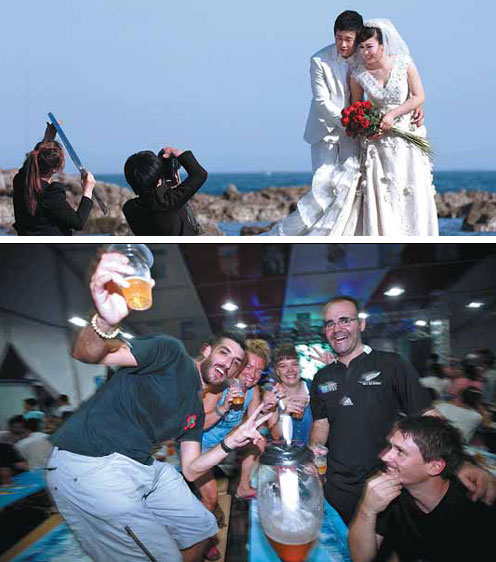 |
|
Qingdao boasts some of the country's best beaches, where brides and grooms throng for their wedding photo shoots. The annual beer festival attracts visitors from home and abroad. Photos by Huang Jiexian and Xu Chongde / For China Daily
|
A German settlement more than 100 years ago left a brewery that would make Qingdao a world-famous name. But there was another intoxicating element it helped create. Robert Willox reports.
Love is in the air. Well, it often seems to be when you're traveling in China. For, aside from the main historical attractions, the sights we like to see and photograph are by and large the same ones as Chinese newlyweds choose, and mostly for the same reason - romance.
From the Chinese perspective at least, you can probably tell how interesting, beautiful and accessible a place is in China by the variety of opportunities it provides for wedding shots. If so, when it comes to the romance rankings, Qingdao has got to be fairly high up the list.
This is due to two main ingredients - its seaside location and the Germans.
It was because of the former that the latter grabbed the place in 1897 to serve as a port. The Germans "took out a 99-year lease under treaty". Alas, they were there for barely 17 years until the onset of World War I.
But, regardless of subsequent events, what they built in that short time is impressive, and equally remarkable is how much of it has survived and is being utilized today.
Prime among the legacy list is of course the brewery, built in 1903 in what was then known as Tsingtao, before being amended to Qingdao under the modern pinyin phonetic system. Part of the original building still operates as Tsingtao's No 1 brewery, and incorporates a museum where you can drink in the stories that led the Chinese company to international success.
But too much beer dampens romance. You won't find newlyweds posing outside the brewery or honeymooning at the 23rd International Beer Festival taking place on the east side of the city.
Let's stick to the sedate old town in the west, where most wedding photo shoots take to the rocks edging the beaches, bays and headlands.
Apart from the Yellow Sea, one particularly popular backdrop is a granite mansion, Hua Shi Lou, sitting on a point separating and overlooking No 2 and No 3 beaches. Inside, the rooms are bare. An odd photograph dots the walls here and there, including one of Chiang Kai-shek, who it is claimed stayed there in secret in 1947.
But history doesn't matter here. Most visitors rush up to the turret platform for the 360-degree views.
One of those will be of the Badaguan scenic area, a grid of big homes and lush, tree-lined avenues that mark the beginning of the German quarter.
Further west, near the top of Signal Hill, there's a more impressive manor to visit - and it's fully furnished with all the original furniture and fittings.
This 1908 schloss was the German governor's residence or Ying Bin Guan. It was later used as a guest house by the authorities for visiting dignitaries. Mao Zedong stayed there on holiday in the late 1950s.
One of the opulent rooms currently features an exhibition of models of other German architecture in the area.
Perhaps the most intriguing building still in operation is the one that was to become the headquarters of the Red Swastika Society.
